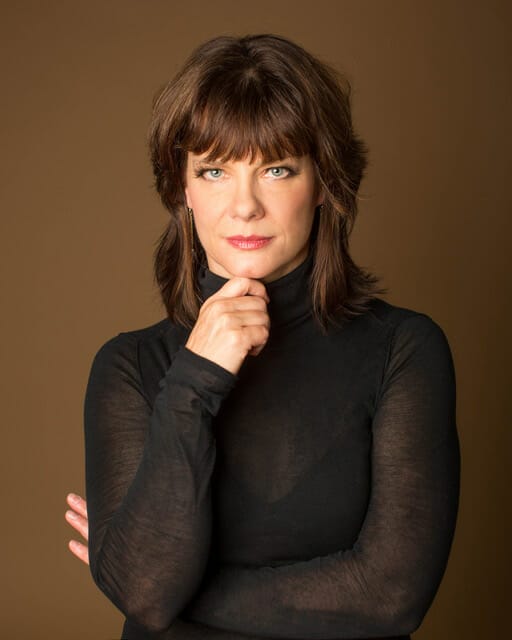Editor's Note - This is part of Picture this Post's series - CHOREOGRAPHERS' EYES - DANCERS EXPLAIN DANCE. Find more here.
Learn more about dance by seeing dance through dancers eyes in the Picture This Post series, “Choreographers’ Eyes - Dancers Explain Dance”. Watch this video preview of the story here—
Find more Picture This Post dance reviews in the latest roundup — CHOREOGRAPHERS WE LOVE. Also, watch a short preview video here —
DCASE On Edge Festival hosts lil BLK
NIC Kay, who performed their solo evening length performance lil BLK at Hamlin Park Fieldhouse as part of DCASE’s On Edge Festival, describes themself as “a person who makes performances and creates/organizes performative spaces.” They “explore movement as a place of reclamation of the body, history and spirituality.”
Scene in Hamlin Park Theatre
Upon entering the Hamlin Park Theatre one sees there are already a variety of objects on the stage. A standing microphone downstage right, an industrial type floor fan upstage center, and what might be a clothes line with a white dress on a hanger and an afghan on the floor alongside a floor light downstage left. The objects, although seemingly disconnected, immediately create questions and speculation about what their context might be, and how they will be utilized.
Dramatic entrance
The performance begins with NIC Kay entering stage right, crawling along the proscenium of the elevated stage at the very back of the theatre dressed in a white long sleeved shirt, white briefs, white knee pads, and white running shoes. They enter and begin moving, back to the audience, accompanied by recordings of a very young female child listing her dreams and aspirations and how she plans on getting there. It is a sweet and hopeful recording of the innocence and honesty of a child accompanying a young adult dancer. As NIC Kay moves from the elevated proscenium to the lower part of the stage they begin a monolog as the character of a young black girl talking about dancing and what it feels like. The character lets us know that the way she is dancing is about being in your body and dancing in your body and how the dance is not what adults perceive it to be, but an avenue to freedom and to being yourself. The dancing, although often misinterpreted, our young girl tells us, is evidence of who you are and how a body moving is the expression of who you are. She then goes on to list a host of things she understands you cannot, and should not, be…too smart, too beautiful, too ugly…an impossible list to live by.
Many themes, many metaphors
Themes that begin to emerge as the performance unfolds include, a young girl coming to terms with her sexuality and the realization that her desires are outside the norm of family, community and society. A struggle with faith and religion through repeated prayers and questions. The text eventually gives way to a broken limbed dance framed in a square of light where the dancer moves repeatedly from standing upright to the floor, frantic and staccato, crawling forward and falling back, fluorescent lights flashing as if to evoke images of a nightclub, to finally finishing, exhausted from the movement and perhaps a metaphorical battle of trying to be true to one’s authentic self.
NIC Kay then disappears towards the back wall on the raised proscenium. They open the door and a bright light shines directly at the audience as they exit. We are left for a long time facing the bright light, wondering if NIC will return, sitting and considering the text and movement we have just witnessed and wondering if this marked the end of the performance.
After a costume change
After a few minutes NIC Kay remerges in a change of costume energetically moving all around the stage. The dancing is luscious and energetic, the choreography a mixture of everyday quotidian, repetitive patterns, and endless spinning. NIC Kay’s long lithe body embraces the space and erupts with dynamic force. After the constraint of the first half, this second part of the performance is filled with what seemed like an exhalation and a freedom to move and breathe. As the dance comes to an end we hear a phone conversation. It’s almost as if we, the audience, are eavesdropping on a personal call, one that describes a freeing experience, but also a lonely one because another person is missing. That revelation evolves and NIC Kay again moves to that raised proscenium, balancing, back to the audience, and then tentatively moving back and forth on the edge of platform.
Powerful ending
From the edge of the stage NIC Kay returns once again to the afghan left on the floor downstage left bringing us metaphorically back to the young child with all her hopes and dreams and struggles and doubts that we encountered at the beginning of the performance. We feel as if we have been on a long journey. NIC worms their way into the afghan emerging, head engulfed, as the blanket becomes a knitted garment in the shape of a robe or dress. NIC begins to move, face covered, at first tentatively feeling their way about the space. Slowly and gradually they begin to swirl and twirl sending the garment splaying outward like a full skirt or religious robe. The energy does not last long and eventually the garment begins to weigh the dancer down until they finish on the floor, engulfed in one center light creating a strangely beautiful image and shape as they remain covered and safely protected.
Chicago’s Department of Cultural Affairs and Special Events (DCASE) hosts ongoing music, dance, film, art and other cultural events—most free of charge. To find out more about DCASE events in the upcoming calendar visit their web pages.
Editor's Note - This is part of Picture this Post's series - CHOREOGRAPHERS' EYES - DANCERS EXPLAIN DANCE. Find more here.



